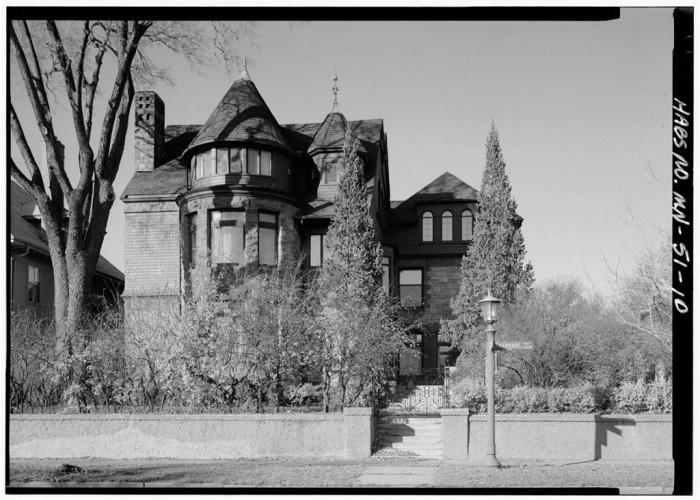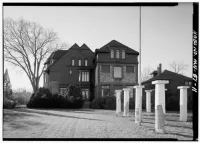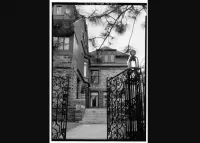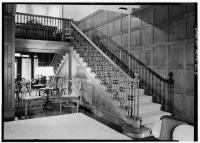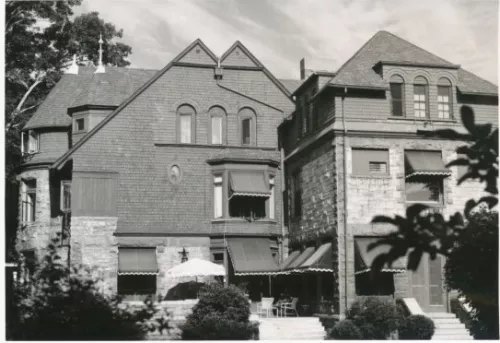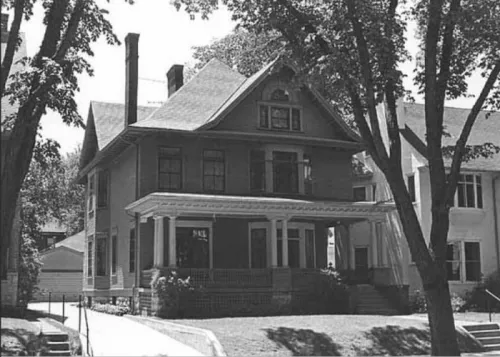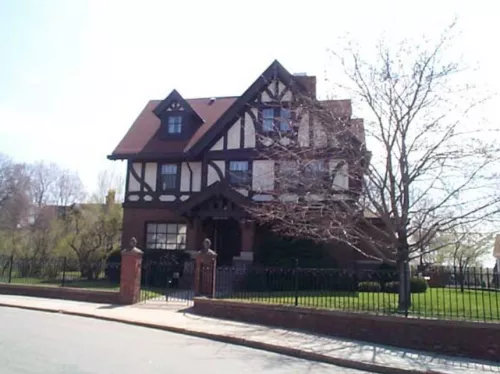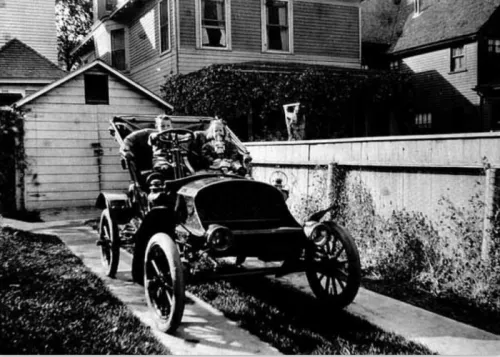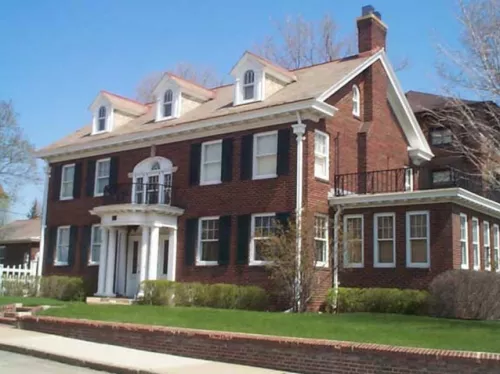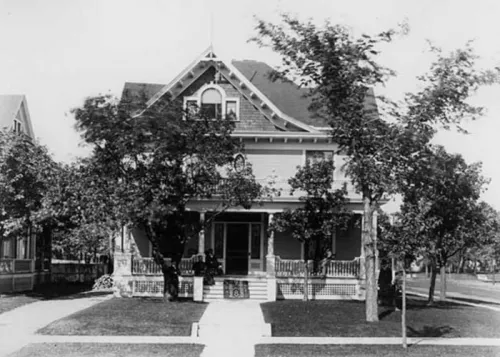Share what you know,
and discover more.
Share what you know,
and discover more.
Sep 17, 1974
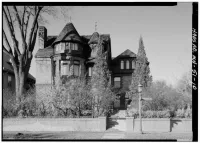
-

- Dave D
National Register of Historic Places
Excerpt from the Statement of Significance: The political career of Frank B. Kellogg is of more than ordinary significance, for he attained prominence on state, national, and international levels. The story of his life is a classic example of the American rags-to-riches story. Born in Potsdam, New York, in 1856, he moved, in 1865, with his family to a farm in Olmsted County, Minnesota. After a minimum of formal education, he spent four years of study in a law office. He was admitted, in 1877, to the bar in Rochester, and formed a partnership with another young self-taught lawyer named Burt Eaton. In 1878, Kellogg was elected City Attorney of Rochester and was defeated for re-election in 1881. He ran against his law partner for the office of County Attorney and won; but in 1885 he lost the Republican nomination for state Attorney General to a man he was to defeat in later years for the Senatorial nomination, Moses Clapp. In 1884, Kellogg undertook a highly complex case on behalf of two Wabasha County townships against the Winona-St. Peter Railroad Company. After seven years of litigation, the case went before the Supreme Court; and Kellogg won it. The reputation that Kellogg made for himself in Rochester won him a job in the most prestigious law office in St. Paul -- the firm of former Governor Cushman Kellogg Davis and Cordenio A. Severance. He moved to St. Paul in 1887 and built this house at 633 Fairmount Avenue in 1889. The firm of Davis, Kellogg and Severance counted among its clients such railroads as the Chicago and Great Western, the Northern Pacific, the Duluth and Iron Range, and the Duluth, Mesabi and Northern, and such corporations as the Pullman Company, the Federal Steel Company, the Minnesota Iron Company, the Oliver Iron Mining Company, and when the latter two were sold, the United States Steel Corporation. During the course of his work with these companies, Kellogg came into contact with such men as James J. Hill, H. H. Porter, H. W. Oliver, Elbert H. Gary, Andrew Carnegie, John D. Rockefeller and J. Pierpont Morgan. Kellogg first gained national prominence as a trust-busting lawyer, having been involved on behalf of the Federal government in the prosecution of the General Paper Company, the Northern Securities Case, the Union Pacific, Southern Pacific and subsidiary railroads and the Standard Oil Case. The solid foundation of his fortune, however, was based on his connections as a corporation lawyer, in the course of which he amassed a great wealth. Politically, Kellogg's status during and following the Standard Oil case was to be better than at any time during his career until after the Kellogg-Briand Peace pact was negotiated. He was considered for appointment as Secretary of War and as Justice of the Supreme Court, and there was some talk of his being Taft's running mate in 1908. None of these prospects materialized and Kellogg settled for the Presidency of the American Bar Association, in 1912-1913. In 1916, Kellogg won the Republican Senatorial nomination, over formidable opposition; Governor Adolph 0. Eberhardt, the incumbent "insurgent" Senator Moses Clapp, and Representative Charles A. Lindbergh, Sr. In the November election Kellogg defeated his Democratic opponent decisively, outdrawing presidential candidate Charles Evans Hughes in the Minnesota voting. His major committee assignments in the Senate included the Judiciary, Interstate Commerce, National Banks, Public Lands, a joint committee for the revision of the laws of the United States, and, after the League of Nations debate. Foreign Relations. When Kellogg's term came to an end, in 1922, he was defeated for re-election by Henrik Shipstead. After this defeat, Kellogg planned to return to his law office, but instead, he went to Santiago as a delegate to the Fifteenth International Conference of American States. In December of 1923 Kellogg was appointed by President Coolidge to be Ambassador to the Court of St. James. He became one of few foreigners ever elected an Honorary Bencher of the Middle Temple, the oldest of the Inns of Court. While ambassador to England, Kellogg played an important role in the negotiation of the Dawes plan of economic reparations. Kellogg was appointed Secretary of State by Coolidge when Charles Evans Hughes resigned. While Secretary of State, from 1925-1929, he passed on the merits of many questions of international significance, including disputes with China and various Latin American countries. The culmination of Kellogg's Cabinet career was the signing of the Kellogg-Briand pact to outlaw war. In 1930, Kellogg accepted the Nobel Peace Prize and assumed duties at the Hague, as a judge on the Permanent Court of International Justice. He resigned from the Court in September 1935, because of illness. The next year marked, in effect, the end of all of Kellogg's other duties. Kellogg died in December 1937 at his home on Fairmount Avenue. The Frank B. Kellogg House is significant, architecturally, in its own right for it is an unusual but beautifully blended combination of two architectural styles: the Queen Anne and the Romanesque. It is one of the most well-known houses, architecturally as well as historically, in a very high-quality residential neighborhood of Saint Paul which sports no lack of either.
National Register of Historic Places
Excerpt from the Statement of Significance: The political career of Frank B. Kellogg is of more than ordinary significance, for he attained prominence on state, national, and international levels. The story of his life is a classic example of the American rags-to-riches story. Born in Potsdam, New York, in 1856, he moved, in 1865, with his family to a farm in Olmsted County, Minnesota. After a minimum of formal education, he spent four years of study in a law office. He was admitted, in 1877, to the bar in Rochester, and formed a partnership with another young self-taught lawyer named Burt Eaton. In 1878, Kellogg was elected City Attorney of Rochester and was defeated for re-election in 1881. He ran against his law partner for the office of County Attorney and won; but in 1885 he lost the Republican nomination for state Attorney General to a man he was to defeat in later years for the Senatorial nomination, Moses Clapp. In 1884, Kellogg undertook a highly complex case on behalf of two Wabasha County townships against the Winona-St. Peter Railroad Company. After seven years of litigation, the case went before the Supreme Court; and Kellogg won it. The reputation that Kellogg made for himself in Rochester won him a job in the most prestigious law office in St. Paul -- the firm of former Governor Cushman Kellogg Davis and Cordenio A. Severance. He moved to St. Paul in 1887 and built this house at 633 Fairmount Avenue in 1889. The firm of Davis, Kellogg and Severance counted among its clients such railroads as the Chicago and Great Western, the Northern Pacific, the Duluth and Iron Range, and the Duluth, Mesabi and Northern, and such corporations as the Pullman Company, the Federal Steel Company, the Minnesota Iron Company, the Oliver Iron Mining Company, and when the latter two were sold, the United States Steel Corporation. During the course of his work with these companies, Kellogg came into contact with such men as James J. Hill, H. H. Porter, H. W. Oliver, Elbert H. Gary, Andrew Carnegie, John D. Rockefeller and J. Pierpont Morgan. Kellogg first gained national prominence as a trust-busting lawyer, having been involved on behalf of the Federal government in the prosecution of the General Paper Company, the Northern Securities Case, the Union Pacific, Southern Pacific and subsidiary railroads and the Standard Oil Case. The solid foundation of his fortune, however, was based on his connections as a corporation lawyer, in the course of which he amassed a great wealth. Politically, Kellogg's status during and following the Standard Oil case was to be better than at any time during his career until after the Kellogg-Briand Peace pact was negotiated. He was considered for appointment as Secretary of War and as Justice of the Supreme Court, and there was some talk of his being Taft's running mate in 1908. None of these prospects materialized and Kellogg settled for the Presidency of the American Bar Association, in 1912-1913. In 1916, Kellogg won the Republican Senatorial nomination, over formidable opposition; Governor Adolph 0. Eberhardt, the incumbent "insurgent" Senator Moses Clapp, and Representative Charles A. Lindbergh, Sr. In the November election Kellogg defeated his Democratic opponent decisively, outdrawing presidential candidate Charles Evans Hughes in the Minnesota voting. His major committee assignments in the Senate included the Judiciary, Interstate Commerce, National Banks, Public Lands, a joint committee for the revision of the laws of the United States, and, after the League of Nations debate. Foreign Relations. When Kellogg's term came to an end, in 1922, he was defeated for re-election by Henrik Shipstead. After this defeat, Kellogg planned to return to his law office, but instead, he went to Santiago as a delegate to the Fifteenth International Conference of American States. In December of 1923 Kellogg was appointed by President Coolidge to be Ambassador to the Court of St. James. He became one of few foreigners ever elected an Honorary Bencher of the Middle Temple, the oldest of the Inns of Court. While ambassador to England, Kellogg played an important role in the negotiation of the Dawes plan of economic reparations. Kellogg was appointed Secretary of State by Coolidge when Charles Evans Hughes resigned. While Secretary of State, from 1925-1929, he passed on the merits of many questions of international significance, including disputes with China and various Latin American countries. The culmination of Kellogg's Cabinet career was the signing of the Kellogg-Briand pact to outlaw war. In 1930, Kellogg accepted the Nobel Peace Prize and assumed duties at the Hague, as a judge on the Permanent Court of International Justice. He resigned from the Court in September 1935, because of illness. The next year marked, in effect, the end of all of Kellogg's other duties. Kellogg died in December 1937 at his home on Fairmount Avenue. The Frank B. Kellogg House is significant, architecturally, in its own right for it is an unusual but beautifully blended combination of two architectural styles: the Queen Anne and the Romanesque. It is one of the most well-known houses, architecturally as well as historically, in a very high-quality residential neighborhood of Saint Paul which sports no lack of either.
Sep 17, 1974
National Register of Historic Places
Excerpt from the Statement of Significance:The political career of Frank B. Kellogg is of more than ordinary significance, for he attained prominence on state, national, and international levels. The story of his life is a classic example of the American rags-to-riches story. Born in Potsdam, New York, in 1856, he moved, in 1865, with his family to a farm in Olmsted County, Minnesota. After a minimum of formal education, he spent four years of study in a law office. He was admitted, in 1877, to the bar in Rochester, and formed a partnership with another young self-taught lawyer named Burt Eaton.
In 1878, Kellogg was elected City Attorney of Rochester and was defeated for re-election in 1881. He ran against his law partner for the office of County Attorney and won; but in 1885 he lost the Republican nomination for state Attorney General to a man he was to defeat in later years for the Senatorial nomination, Moses Clapp. In 1884, Kellogg undertook a highly complex case on behalf of two Wabasha County townships against the Winona-St. Peter Railroad Company. After seven years of litigation, the case went before the Supreme Court; and Kellogg won it.
The reputation that Kellogg made for himself in Rochester won him a job in the most prestigious law office in St. Paul -- the firm of former Governor Cushman Kellogg Davis and Cordenio A. Severance. He moved to St. Paul in 1887 and built this house at 633 Fairmount Avenue in 1889.
The firm of Davis, Kellogg and Severance counted among its clients such railroads as the Chicago and Great Western, the Northern Pacific, the Duluth and Iron Range, and the Duluth, Mesabi and Northern, and such corporations as the Pullman Company, the Federal Steel Company, the Minnesota Iron Company, the Oliver Iron Mining Company, and when the latter two were sold, the United States Steel Corporation. During the course of his work with these companies, Kellogg came into contact with such men as James J. Hill, H. H. Porter, H. W. Oliver, Elbert H. Gary, Andrew Carnegie, John D. Rockefeller and J. Pierpont Morgan.
Kellogg first gained national prominence as a trust-busting lawyer, having been involved on behalf of the Federal government in the prosecution of the General Paper Company, the Northern Securities Case, the Union Pacific, Southern Pacific and subsidiary railroads and the Standard Oil Case. The solid foundation of his fortune, however, was based on his connections as a corporation lawyer, in the course of which he amassed a great wealth.
Politically, Kellogg's status during and following the Standard Oil case was to be better than at any time during his career until after the Kellogg-Briand Peace pact was negotiated. He was considered for appointment as Secretary of War and as Justice of the Supreme Court, and there was some talk of his being Taft's running mate in 1908. None of these prospects materialized and Kellogg settled for the Presidency of the American Bar Association, in 1912-1913.
In 1916, Kellogg won the Republican Senatorial nomination, over formidable opposition; Governor Adolph 0. Eberhardt, the incumbent "insurgent" Senator Moses Clapp, and Representative Charles A. Lindbergh, Sr. In the November election Kellogg defeated his Democratic opponent decisively, outdrawing presidential candidate Charles Evans Hughes in the Minnesota voting. His major committee assignments in the Senate included the Judiciary, Interstate Commerce, National Banks, Public Lands, a joint committee for the revision of the laws of the United States, and, after the League of Nations debate. Foreign Relations. When Kellogg's term came to an end, in 1922, he was defeated for re-election by Henrik Shipstead.
After this defeat, Kellogg planned to return to his law office, but instead, he went to Santiago as a delegate to the Fifteenth International Conference of American States. In December of 1923 Kellogg was appointed by President Coolidge to be Ambassador to the Court of St. James. He became one of few foreigners ever elected an Honorary Bencher of the Middle Temple, the oldest of the Inns of Court. While ambassador to England, Kellogg played an important role in the negotiation of the Dawes plan of economic reparations.
Kellogg was appointed Secretary of State by Coolidge when Charles Evans Hughes resigned. While Secretary of State, from 1925-1929, he passed on the merits of many questions of international significance, including disputes with China and various Latin American countries. The culmination of Kellogg's Cabinet career was the signing of the Kellogg-Briand pact to outlaw war. In 1930, Kellogg accepted the Nobel Peace Prize and assumed duties at the Hague, as a judge on the Permanent Court of International Justice. He resigned from the Court in September 1935, because of illness. The next year marked, in effect, the end of all of Kellogg's other duties. Kellogg died in December 1937 at his home on Fairmount Avenue.
The Frank B. Kellogg House is significant, architecturally, in its own right for it is an unusual but beautifully blended combination of two architectural styles: the Queen Anne and the Romanesque. It is one of the most well-known houses, architecturally as well as historically, in a very high-quality residential neighborhood of Saint Paul which sports no lack of either.
Posted Date
Jan 22, 2022
Historical Record Date
Sep 17, 1974
Source Name
Library of Congress
Delete Story
Are you sure you want to delete this story?
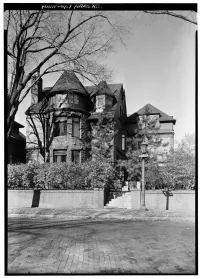
-

- Marley Zielike
Frank Billings Kellogg House, 633 Fairmont Ave Saint Paul, Ramsey County, MN
Built for Frank B. Kellogg, while he was an attorney with Davis, Kellogg & Severance; later he served as U.S. senator, Secretary of State under Calvin Coolidge, co-sponsor of the Kellogg-Briand Pact for which he received the 1930 Nobel Peach Prize. Kellogg died in the house in 1937.
Frank Billings Kellogg House, 633 Fairmont Ave Saint Paul, Ramsey County, MN
Built for Frank B. Kellogg, while he was an attorney with Davis, Kellogg & Severance; later he served as U.S. senator, Secretary of State under Calvin Coolidge, co-sponsor of the Kellogg-Briand Pact for which he received the 1930 Nobel Peach Prize. Kellogg died in the house in 1937.
Frank Billings Kellogg House, 633 Fairmont Ave Saint Paul, Ramsey County, MN
Built for Frank B. Kellogg, while he was an attorney with Davis, Kellogg & Severance; later he served as U.S. senator, Secretary of State under Calvin Coolidge, co-sponsor of the Kellogg-Briand Pact for which he received the 1930 Nobel Peach Prize. Kellogg died in the house in 1937.Posted Date
Sep 27, 2021
Source Name
Library of Congress
Source Website
Delete Story
Are you sure you want to delete this story?
